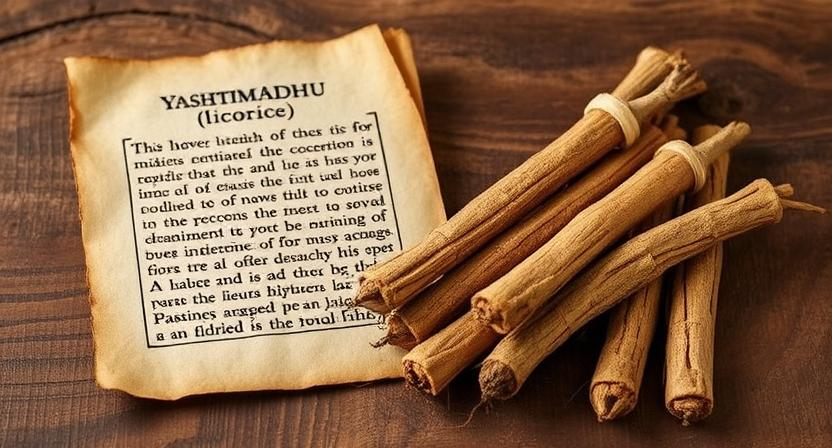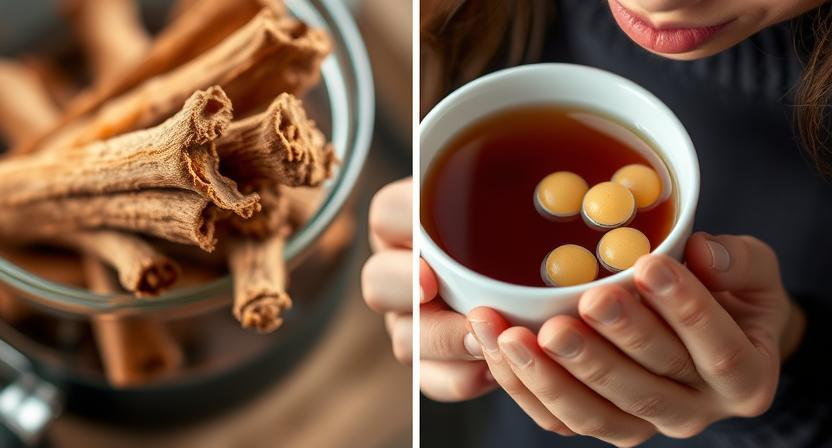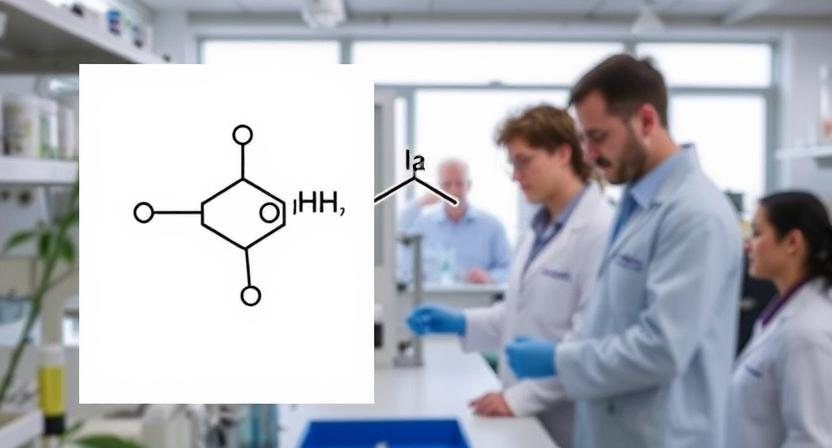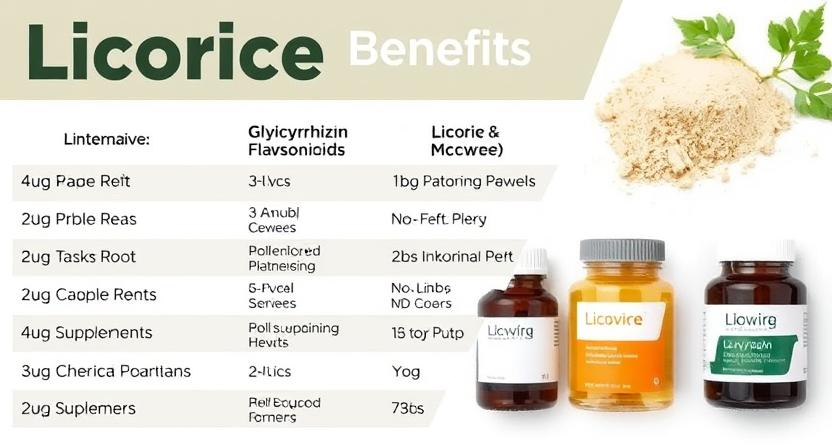Licorice (Glycyrrhiza glabra): Overview
Licorice, scientifically known as Glycyrrhiza glabra, is a perennial herb native to Europe and Asia. Its root has been used for centuries in traditional medicine systems, including Ayurveda, Traditional Chinese Medicine (TCM), and Western herbalism.
Known for its sweet flavor and potent medicinal properties, it is particularly revered for its ability to support throat health and adrenal function. This article explores the uses, benefits, and scientific evidence behind it as a natural remedy for throat health and adrenal support.
Table of Contents
The Historical Roots of Licorice

it has a rich history dating back thousands of years. Ancient Egyptians, Greeks, and Chinese civilizations used it for its healing properties. In Ayurveda, licorice is known as Yashtimadhu and is classified as a Rasayana (rejuvenating herb). It is traditionally used to soothe the throat, support digestion, and balance the body’s energy. Similarly, in TCM, it is considered a harmonizing herb, often included in formulations to enhance the effects of other herbs and support overall vitality.
Licorice for Throat Health

it is widely recognized for its ability to soothe and protect the throat. Its demulcent properties form a protective layer over the mucous membranes, reducing irritation and inflammation. This makes it an excellent remedy for conditions such as sore throat, cough, and laryngitis. it also has expectorant properties, helping to loosen and expel mucus from the respiratory tract.
Key Benefits for Throat Health:
- Soothes sore throat and reduces irritation.
- Alleviates cough and promotes mucus clearance.
- Reduces inflammation in the throat and respiratory tract.
- Protects mucous membranes from further damage.
Licorice for Adrenal Support
The adrenal glands play a crucial role in managing stress by producing hormones like cortisol. Chronic stress can lead to adrenal fatigue, characterized by symptoms such as fatigue, low energy, and weakened immunity. it supports adrenal health by slowing the breakdown of cortisol, allowing the body to maintain balanced energy levels and better cope with stress.
Key Benefits for Adrenal Support:
- Helps regulate cortisol levels and reduce adrenal fatigue.
- Boosts energy and combats chronic fatigue.
- Supports the body’s response to stress.
- Enhances overall vitality and resilience.
The Science Behind Licorice’s Benefits
it contains several bioactive compounds, including glycyrrhizin, flavonoids, and polysaccharides, which contribute to its therapeutic effects. Glycyrrhizin, the most studied compound, is responsible for licorice’s anti-inflammatory, antiviral, and immune-modulating properties. Below is a table outlining the key chemical components of licorice per 100g, along with their uses and benefits:

| Chemical Component | Amount per 100g | Uses and Benefits |
|---|---|---|
| Glycyrrhizin | 2–15g | Anti-inflammatory, antiviral, adrenal support, throat health. |
| Flavonoids | 1–3g | Antioxidant, anti-inflammatory, immune support. |
| Polysaccharides | 5–10g | Soothes mucous membranes, supports throat health. |
| Coumarins | 0.1–0.5g | Anti-inflammatory, antimicrobial. |
| Vitamin E | 2mg | Antioxidant, supports skin and immune health. |
| Potassium | 400mg | Regulates blood pressure, supports heart health. |
| Magnesium | 50mg | Supports muscle and nerve function, reduces stress. |
Scientific and Ayurvedic Evidence
Scientific Evidence
Modern research supports many of its traditional uses. A 2017 study published in the Journal of Ethnopharmacology found that it root extract effectively reduced throat inflammation and cough. Another study in the Journal of Clinical Endocrinology & Metabolism highlighted its ability to modulate cortisol levels, making it beneficial for adrenal fatigue. Additionally, its antiviral properties have been shown to inhibit the replication of viruses, including those causing respiratory infections.
Ayurvedic Evidence
In Ayurveda, it is classified as having a sweet (Madhura) taste and a cooling (Sheeta) energy. It is used to balance Pitta and Vata doshas and is particularly effective for treating Kasa (cough) and Svasa (breathing difficulties). Ayurvedic texts like the Charaka Samhita recommend it for its Shothahara (anti-inflammatory) and Vranaropana (wound-healing) properties.
Practical Ways to Incorporate Licorice into Your Routine
it can be consumed in various forms, depending on your needs and preferences. Here are some practical ways to use it :
- Tea: Steep it root in hot water for a soothing drink.
- Lozenges: Use for quick relief from sore throat and cough.
- Powder: Add to smoothies, teas, or herbal formulations.
- Supplements: Available as capsules or extracts for adrenal support.
- Tincture: Use in small doses for immune and adrenal support.
Precautions and Considerations
While it is generally safe, excessive consumption can lead to side effects such as high blood pressure, low potassium levels, and fluid retention. People with hypertension, kidney disease, or heart conditions should avoid high doses of it . Pregnant and breastfeeding women should consult a healthcare provider before using it .
Top 15 Uses and Benefits of Licorice

| No. | Use/Benefit | Description |
|---|---|---|
| 1 | Soothes Sore Throat | Reduces irritation and inflammation in the throat. |
| 2 | Relieves Cough | Acts as an expectorant, helping to clear mucus. |
| 3 | Supports Adrenal Health | Regulates cortisol levels and combats adrenal fatigue. |
| 4 | Boosts Immunity | Enhances immune function and fights infections. |
| 5 | Reduces Inflammation | Alleviates inflammation in the throat, respiratory tract, and joints. |
| 6 | Improves Digestion | Soothes the digestive tract and reduces acidity. |
| 7 | Promotes Skin Health | Treats eczema, psoriasis, and other skin conditions. |
| 8 | Supports Liver Health | Detoxifies the liver and improves its function. |
| 9 | Balances Hormones | Helps regulate cortisol and estrogen levels. |
| 10 | Fights Viral Infections | Inhibits the replication of viruses, including respiratory viruses. |
| 11 | Reduces Stress and Fatigue | Supports adrenal function and boosts energy levels. |
| 12 | Protects Mucous Membranes | Forms a protective layer over mucous membranes in the throat and stomach. |
| 13 | Improves Respiratory Health | Eases symptoms of asthma, bronchitis, and other respiratory conditions. |
| 14 | Antioxidant Properties | Fights free radicals and reduces oxidative stress. |
| 15 | Promotes Wound Healing | Accelerates the healing of wounds and ulcers. |
Conclusion
it (Glycyrrhiza glabra) is a versatile herb with a long history of use for throat health and adrenal support. Its soothing, anti-inflammatory, and immune-boosting properties make it a valuable addition to any wellness routine. Whether consumed as tea, lozenges, or supplements, it offers a natural and effective solution for a variety of health concerns.
As with any herbal remedy, it is essential to use it mindfully and consult a healthcare professional if you have any concerns. By harnessing the power of this ancient herb, you can support your throat, adrenal glands, and overall well-being in a gentle and holistic way.
FAQs About Licorice (Glycyrrhiza glabra)
1. What is the use of licorice (Glycyrrhiza glabra)?
it is used for throat health, adrenal support, digestive issues, immune boosting, and reducing inflammation. It is also beneficial for skin health, hormonal balance, and respiratory conditions.
2. Who should not eat licorice?
People with high blood pressure, kidney disease, heart conditions, or low potassium levels should avoid it . Pregnant and breastfeeding women should also use it cautiously.
3. What does licorice do to the body?
it soothes the throat, supports adrenal function, reduces inflammation, boosts immunity, and promotes digestive health. It also has antiviral and antioxidant properties.
4. नद्यपान शरीर को क्या करता है?
नद्यपान (मुलेठी) गले को आराम देता है, एड्रेनल ग्रंथियों को सपोर्ट करता है, सूजन कम करता है, इम्यूनिटी बढ़ाता है, और पाचन तंत्र को मजबूत करता है।
5. What are the side effects of mulethi?
Excessive consumption of it (mulethi) can cause high blood pressure, low potassium levels, fluid retention, and hormonal imbalances.
6. Is licorice bad for the liver?
In moderate amounts, it is not bad for the liver. However, excessive use may lead to liver toxicity in rare cases.
7. Is licorice good for hair growth?
Yes, it promotes hair growth by improving scalp circulation and reducing dandruff. It is often used in hair oils and masks.
8. What is the Indian name for Glycyrrhiza glabra?
The Indian name for Glycyrrhiza glabra is Mulethi or Yashtimadhu.
9. How much licorice is safe?
Up to 5–10g of it root per day is considered safe for most adults. However, prolonged use should be avoided.
10. Does licorice lighten skin?
Yes, it has skin-brightening properties and is often used in skincare products to reduce pigmentation and even out skin tone.
11. Which herb makes hair thicker?
it , along with herbs like amla, bhringraj, and fenugreek, is known to promote thicker and healthier hair.
12. Is it OK to eat liquorice every day?
Eating it in small amounts daily is generally safe, but long-term or excessive use can lead to side effects like high blood pressure.
13. Is ashwagandha good for fatty liver?
Yes, ashwagandha has hepatoprotective properties and may help reduce fat accumulation in the liver.
14. Does licorice cause weight gain?
it may cause water retention, leading to temporary weight gain. However, it does not directly cause fat gain.
15. Is garlic bad for the liver?
No, garlic is beneficial for liver health as it supports detoxification and reduces oxidative stress.
16. Does licorice remove facial hair?
No, it does not remove facial hair. It is primarily used for skin health and inflammation.
17. Is licorice good for the brain?
Yes, it has neuroprotective properties and may help improve cognitive function and reduce oxidative stress in the brain.
18. Which drink is best for hair regrowth?
Herbal teas like it tea, green tea, or amla juice are excellent for promoting hair regrowth.
19. Does licorice raise BP?
Yes, excessive consumption of it can raise blood pressure due to its glycyrrhizin content.
20. Can Muslims eat liquorice?
Yes, it is halal and permissible for Muslims to consume.
21. Is licorice high in sugar?
Natural it root is not high in sugar, but it candies and sweets often contain added sugars.
22. Does licorice brighten skin?
Yes, it extract is known to brighten skin and reduce dark spots and pigmentation.
23. What stops hair growth on the face?
Hormonal imbalances, genetics, and certain medical conditions can stop facial hair growth. Treatments like laser therapy or topical creams may help.
24. How to use licorice for hair growth?
Mix it powder with coconut oil or aloe vera gel, apply to the scalp, and leave for 30 minutes before washing. Alternatively, drink it tea regularly.
25. Can type 2 diabetics eat licorice?
Diabetics should use it cautiously, as it may affect blood sugar levels. Consult a doctor before use.
26. Why am I craving liquorice?
Craving it may indicate low cortisol levels, stress, or a deficiency in certain minerals like potassium.
27. Why is licorice black?
Black it gets its color from molasses and anise flavoring, not from the it root itself.
28. Does licorice expire?
Yes, it root and its products have a shelf life. Dried it root can last up to 2–3 years if stored properly.
29. What country is famous for licorice?
The Netherlands is famous for its love of it , with a wide variety of it candies and products.
30. Why do people not like licorice?
Some people dislike it due to its strong, distinct flavor, which can be an acquired taste.
